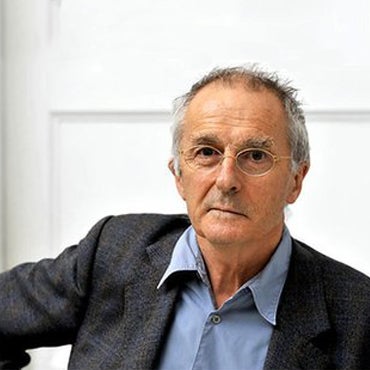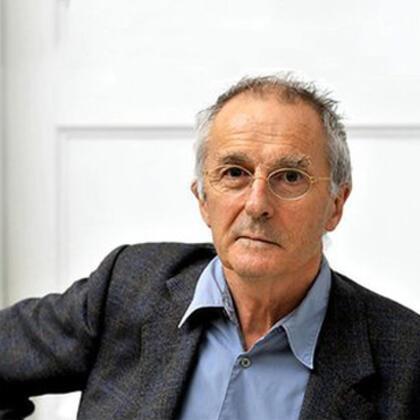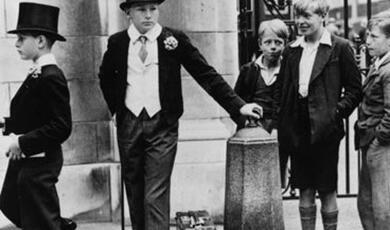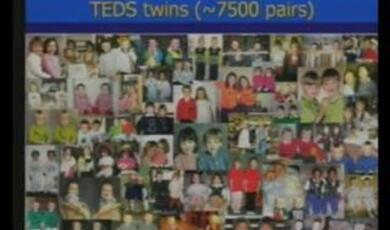Homo Sapiens, an Endangered Species
Share
- Details
- Text
- Audio
- Downloads
- Extra Reading
Mankind, now so abundant, has for long parts of its history been reduced to tiny numbers, and almost to extinction.
I will talk about the evidence for this, about how we reached our present enormous abundance, and what the future of the human population might be.
Download Text
22 March 2016
Homo Sapiens, an Endangered Species?
Professor Steve Jones
This seems an odd question to ask, because of course there has been a huge increase in human population size in the past few thousand years, particularly since the origin of farming. Many people are concerned that this is not sustainable and will collapse as, for example, food runs out.
It is certainly true that not only has the population been growing but the rate of growth has consistently increased. It took 3 billion years from the origin of the human lineage for the first 5 million people. It took from the origin of farming to the birth of Christ, 10,000 years, for the next 170 million people, then 1800 years for the first billion. The second billion, 30 years. In the last 12 years we have put on another 7 billion. And the United Nations estimates that we will peak at about 2050, with around 9000 million people in the world.
We may not be endangered now, but I hope I can persuade you that once, we were. Many other creatures, of course, are. Africa has been the site of many of these, and given the patterns of population growth across the world, looks set to continue that dubious honour. Global fertility reaches a peak in Africa, where in many countries, the mean family size is five or six. As a result, African populations are growing far faster than anywhere else in the world, and the frequency of Africans as a proportion of the world population will rise from about one in six today to almost one in four in 2050. That is particularly unfortunate for our own relatives, the great apes, with more babies being born each year than their total population.
There are now more human babies born every day, about 350,000 of them, than there are individuals left in all the great ape species combined; gorillas, chimpanzees, bonobos and orangutans. The effects on our closest relative, the chimpanzee, have been dramatic. The estimates, however, are very rough. There may have been between one and two million chimpanzees in Africa in 1900, by 1980 there were probably only about 200,000 and today, something like 170,000. Those calculations are very rough, but surveys of the decline of suitable habitats for African great apes suggest some dramatic events to come. In the past 20 years there have been great losses of habitat for the chimpanzee and its relatives as shown here, where green means no loss and red means extreme loss.
Nearly all of this is due to human actions of logging and moving into the forests. And if one projects this into the future, to 2030, the figure is absolutely disastrous. Nearly all the habitats for the great apes will be gone by the year 2030 or so. We may end up being the only great ape left on Earth within the lifetime of some of the people in this room.
It might seem odd then, to suggest that over the great course of evolutionary history, the most endangered primate of all has indeed been the species to which many of us claim to belong, Homo Sapiens. That is a statement not based on simply counting people alive today or guessing at the numbers alive 10,000 or a hundred thousand years ago, but by turning to the record of our ancient population sizes that remains in our genes. We can also do the same for chimpanzees, gorillas and the rest, and we come, as I hope I shall tell you, to some surprising conclusions.
Charles Darwin spent five years on the Beagle, but only 5 weeks in the Galapagos. He realised that the inhabitants were related to, but different from, those on the mainland. Hundreds of island populations have now been studied and there is a general finding that they are less variable than those on the mainland. Islands can be used to illustrate our own history.
Charles Darwin realised that islands were laboratories of evolution, and they still are. The more isolated and smaller the island, the fewer the number of species. This is because many find it hard to cross the ocean and also because the chances of random extinction by accident on a small island is high. And what is true of the numbers of species is also true of the numbers of genes, the extent of inherited diversity, within island populations of many kinds of creatures, humans included.
Due to bottlenecks, the extent of the effect depends on the size of the population over the generations; a process known as genetic drift. It turns on simple statistics. Strength of genetic drift is more noticeable in small populations for obvious statistical reasons. It can be illustrated with coins – spin two coins, spin four coins, spin eight and so on.
In how many are all the coins heads, or all tails? This is obvious – it is much more likely in small samples; if only one pregnant female arrives, the maximum number of genomes available is four. It may be a massive change by accident – random genetic drift. If population stays small for many generations, perhaps because it is on a small island, it will lose more and more genetic variation.
One can see this in experiments with tiddly winks where we do repeated sampling. As the process goes on, in principle you could lose one allele or the other so that you end up with genetically invariant populations – a loss of heterozygosity. The effect is much larger in small populations.
Humans also have the unique advantage of keeping records of their past. Quite often we can see that the record of genes and of written history complement each other.
Just a few weeks ago, Oliver Sacks died at an advanced age. One of his less well-known books is called Pingelap, based on an island in the middle of the Pacific. All inhabitants on the island descend from an unknown survivor of a devastating 18th century hurricane. It turns out that this island today has the highest world frequency of a very rare genetic disease known as achromotopsia, which is effectively night blindness.
In other words, there was a population bottleneck which had a lasting effect.
Another case is closer to home and is interesting because we know exactly who was involved. My new book, No Need for Geniuses, which comes out next week, deals with the science of the years around the French Revolution in 1789.
Of course, Napoleon, who came to power after the revolution was defeated at Waterloo and was exiled to the island of Saint Helena, where he died within five years, supposedly through arsenic poisoning by the dastardly British. As everybody knows, he had already escaped from one island and the British were very anxious that he should not do so again. Napoleon was known to be a good swimmer.
There are many examples of historical bottlenecks. The Island of Tristan da Cunha in the South Atlantic, for example. This island was uninhabited before 1816, after which date a garrison was stationed there as part of a guard of Napoleon, exiled on St Helena, far to the north. In 1817 Napoleon died and the garrison was withdrawn, but a Scottish corporal, William Glass, and his wife, Sarah Williams, and daughter stayed. They were joined by two shipwrecked sailors in 1821 and 1826 who advertised for, and got, wives from South Africa. Over the next fifty years, twenty more people arrived. There were several secondary bottlenecks, for example in 1855 there was a fishing accident followed by emigration that dropped the population from 103 to 33. In 1961 there was a volcanic eruption and the population of then 270 moved to Southampton (temporarily).
Family studies have found that 5 founders contributed more than half of all the genes in 1961, an effect of sampling and drift. The entire gene pool descended from fewer than 20 founders in 1855, and the genes of 8 of these disappeared in that year's bottleneck. By 1871, all marriages were consanguineous (between relatives). Thus there was a close association between genetic drift in small populations and inbreeding.
It turns out that their old population history has led to the world's highest frequency of a rare genetic disease, known as retinoblastoma, an inherited cancer of the eye. It is disadvantageous, but through the accidents of sampling has drifted to high frequencies. It is genetic change without natural selection (indeed, in this case, even in the face of natural selection). Tristan also has very high frequencies of asthma.
In other words, a small population bottleneck long ago can have a lasting effect on even huge population size; the effective population size of any population in genetic terms can be far smaller than its modern census size.
Population bottleneck extent depends on numbers, and one episode of small size can have long-lasting effects. Need to use a special kind of mean to understand it when we look at N over time. This is often used in economics – imagine a mediaeval village with 100 peasants worth £10 a year, and 1 squire worth a million. Average income is around 10 000 a year – but that means very little. One needs a measure that takes account of the extreme disparity in incomes, the harmonic mean. Hhhb
The formula is simple:
Harmonic mean over k generations is
k
1/N1 + 1/N2 + 1/N3 .... + 1/Nk
Imagine a population in which numbers fluctuate from 1000 to 1000 to 1000 to 10 to 1000 over k=5 generations. The harmonic mean is 48, although arithmetic mean is 802. This shows the importance of bottlenecks, which may be unknown and unknowable, as they happened long ago and as we shall see has a large effect on reducing the effective size of all human populations sizes, even when the bottleneck was tens of thousands of years ago.
This can be seen well in human religious isolates, as they are called. Humans are not isolated only by the sea, or by distance over the land ("isolation by distance"; another important part of population genetics theory), but can also be isolated by culture, most of all by religion (William Blake's "mind-forged manacles"). Indeed, it is still the strongest isolating mechanism in Britain. The strongest predictor of who an Orthodox Jew or a strict Muslim will marry is of course that they will marry someone of their own faith, greatly reducing the possible number of mates and increasing the possibility of random change over the years, as long as population numbers stay small.
We can see that hard at work in the modern United States, which was of course the haven for many religious groups, the Pilgrim Fathers included. Many among them fled to escape religious wars and persecution in Europe. Since their arrival, some have kept themselves isolated. One remarkable group are known as the old order Amish. They originally came from Switzerland and were Anabaptists; they believed in adult baptism as they argued that an infant had no idea what it was accepting when it was baptised and that important moment should be delayed until the candidate understood what he or she was doing. They were very much persecuted and one of the common attacks was to find an Anabaptist and throw him into a river so that he could suffer a second baptism as he drowned. In the early 18th century, many of them immigrated to Pennsylvania where some still speak Pennsylvania Dutch, which is in fact a dialect of Swiss German.
A branch of the Anabaptist movement in Germany and Switzerland in the 16th century believed in adult, rather than infant, baptism. Thousands were killed in wars with the Catholic Church. About 4000 fled to the Americas over the 18th century. They are still very insular and believe in old fashioned ways, horses and carts (although some have cars but paint the bumpers black). In 1900, the Old Order Amish numbered only about 5000 and descended from only a hundred or so shared ancestors. They still avoid contact with the non-Amish world, except during the brief "Rumschipringa" (transl. "jumping around") period, in which youth flirt with the devilish goods outside before deciding whether or not to return to their family and faith and get baptised. 80% come back.
There has been recent massive growth after 1900 and it doubles every 20 years or so! There is an average of six children to each family. At present rate, they will be the size of the whole US population today, within a century.
Therefore, they are enormously abundant, but they went through a bottleneck for 10 generations starting around 20 generations ago. All those millions of people will descend from fewer than 200 founders. This still has a lasting effect on genome and will continue to do so.
Two unique diseases, Ellis van Creuveld syndrome and Cartilage-hair hypoplasia (dwarfism) are unique to the Amish, plus about 15 others at relatively high frequency. There are also unusual blood group patterns. Therefore, an ancient bottleneck has had a large effect even on what is now a huge population and will continue to do so for centuries to come.
We can see the effects of such bottlenecks in many religious isolates. The Ashkenazi Jews are now abundant, but until about the 10th century were a very small group who lived mainly in Italy after their exile from Israel. They then moved into the Rhine valley and Eastern Europe with huge increases in numbers from the small founding group. This may explain why they have a high frequency of diseases like Tay-Sachs, again the accidents of sampling. Some suggest that the majority of Ashkenazim descend from just four women who lived shortly before the great population explosion.
There is an additional complication, which further reduces population size compared to a simple count.
We are talking here about the size of the reproducing population, which means we have to take into account differences in sexual strategies in males and females. Darwin noted that in principle at least males could have vast numbers of children if they mate with many females, but females are limited to a maximum set by their biological capacity to reproduce.
In fact, if only a few males reproduce, but many females do, the bottlenecks are smaller down the male line than down the female line, in other words the effective population size overall is smaller than it would be in a population with equal numbers of each sex. This might seem unlikely to be important in humans, but in fact it is surprisingly so, although to a very different degree at different times and in different places.
Humans have probably not had as much sexual selection in the past as, for example in chimps and gorillas. Males are not big, covered in hair with big canines, penis spines or sexual conflict. However, men are taller and more muscular than women, so is this evidence of moderate sexual selection in the past? If so, then some men have many female partners, which means that some men must have none so there is more variance in male mating success and effective population size in males is smaller.
Anthropology hints that the same is, or was, true in many societies. Polygamy (one man, many wives) is much more common than polyandry (one woman, many husbands – the only cases known are in the Himalayan valleys).
One can see the effect in the ratio of male to female variability in numbers of children:
•FINLAND 0.79•NORWAY 1.02•USA 1.27•YANOMAMA (AMAZON) 2.30•XAVANTE (BRAZIL) 3.10•ACHE (PARAGUAY) 4.22•DOGON (MALI) 4.75
In Norway, for example, all men and all women in effect find a partner and there is no effect in sex ratio. In Dogon, though, for example, many males have no children at all while some have many.
In a historical sense, however, that is nothing. Moulay Ismail the Cruel of Morocco who united much of Morocco admitted to having 722 children, probably with 100 or more wives; so that many, perhaps most, men in his court had no children at all.
This can also be seen in a much more modern context.
Mohamed bin Laden, father of Osama, had twenty-two wives, and fifty-three children (and in the year of Osama's birth, he had six). His best known son had, Osama, last time they were counted, five wives and twenty-two children. Plenty of his henchmen die childless. We can work out the pattern in historical terms by looking at the Y chromosome haplotype, which acts somewhat like a surname as an identifier of groups.
An extreme example comes in central Asia, where tens of millions of men bear the same Y-chromosome, which is of course inherited down the male line. The Y chromosome is found within the boundaries of what was once the Mongol Empire. It is almost certainly that of its main founder, Genghis Khan, and his own sons and male descendants such as Kubla Khan. The male population size in that area is still greatly reduced because of that ancient bottleneck.
Now we can turn this logic on its head to work out the size of bottlenecks long ago, many years before any recorded history at all.
Fossils tell us what patterns of movement were across the globe. It is pretty clear that we evolved in Africa as modern humans c100kya. Although there are arguments about the details, with claims that we got out of Africa and then went back in again., the main escape from Africa was probably around 50,000 years ago across the Red Sea or Isthmus and into Europe c45kya. There was a slow movement across Asia, perhaps following coastal plain as seas were much lower than today. Humans were in Australia c45kya. The last continent to be reached was the New World across the Behring strait c15-20kya – very recent! Humans reached the Southern tip of the Americas within c2000 years ago. Remote places like Hawaii, Tahiti, New Zealand were only about 1000 years ago. Therefore there was a very recent and very rapid spread.
Obviously humans did not travel in straight lines, they did not reach South America by swimming the Pacific, or Asia by climbing the Himalayas. Instead, we can work out the approximate track; conventionally measured by the distance from Addis Ababa, North-East Africa, as an arbitrary point of reference and how long it would take to walk to certain areas.
Then we can look at the extent of genetic variation. This shows a striking decrease in heterozygosity, genetic variation, with distance from Addis Ababa; dropping from an average of 0.75 in Africa to 0.45 near the Southern tip of South America. There is a remarkable straight line drop with distance travelled. This gives us strong evidence for repeated sampling events, a series of bottlenecks on the way out of Africa.
In principle, we can measure the size of the bottleneck by comparing the variation at one point with that in the previous one. This was first done in 1987 by me, in fact, with colleague, Iranian physicist, Shahin Rouhani, on then very primitive data. We estimated that the loss of heterozgosity was equivalent to one generation in which just six people moved from Africa to what is now the Sinai peninsula. This was very naïve as it did not take into account the possibility that a bottleneck lasted for several generations.
However, modern estimates are not very far from that. For example, the out of Africa bottleneck was c 40 individuals, with c65 into Europe, 4800 into India (bigger than most) and 55 into America.
There were repeated small bottlenecks as humans moved onwards. If one takes into account growth until now, with world population now more than 6 billion, then there has been some increase in the "effective population size" (averaged, using harmonic mean, from first bottleneck until today).
Figures are still startling and there is a striking effect of the differences in sexual success variation between men and women which gives remarkably small effective population sizes and estimates of overall bottleneck as humans move into empty lands, and, today, have much increased in number.
EFFECTIVE BOTTLENECK SIZE
ORIGINAL WITH MODERN POP INCREASE
Men Women Men Women
Out of Africa 15 26 -- --
Into Europe 18 118 3800 8000
Into India 74 1663 8600 29500
Into Australia 30 52 2100 3500
Into Americas 21 90 700 1800
In fact, there has been some even more arcane treatment of the global data on polymorphism levels that try to estimate population size back for several million years. These are full of assumptions and rather hard to follow, but the claim is that around 3 million years ago the ancestors of the KhoiSan (Bushmen) were the most abundant group; that there was a general drop in numbers in Africa for unknown reasons about half a million years ago followed by a further decline in the numbers of ancestors of Europeans and Asians, which continued as they spread across the empty Old World.
There are also remarkable findings from fossil DNA. We have now sequenced several Neanderthals and one Denisovan from one tooth from a cave in Siberia, and we can compare this with the effective size of modern populations. It has also been possible to measure the amount of genetic diversity in fossil material. It turns out to be very low compared with modern populations of humans and even lower than most apes. Therefore we can estimate the effective population size. Estimates of population size for Neanderthals vary around 1500 in most places, for Denisovans only about 2 500 while the Yoruba of Nigeria who have never been through such a bottleneck have a population size of many tens of thousands.
What about man in even older times? Heterozygosity was low, showing an ancient bottleneck.
We can use exactly the same logic on chimpanzees. It is already clear that man is the least variable of the primates as when put on a family tree, we find that the red lines to man are much shorter than those of, for example, chimps and gorillas – man is the primate that did not evolve! In fact if we look closely at the chimpanzee, we find groups close to each other in West Africa that are far more different from each other than are any two human populations. We did not evolve in our bodies but in our minds.
We can use the bottleneck logic to work out the effective population size of chimpanzees over time. In fact, a startling suggestion is that humans are much less variable than chimps and gorillas; perhaps our history even in Africa is of a rare and endangered species, a permanent bottleneck. There are now thousands of times more humans than chimps, but if you do the genetics and work out population for most of history, the opposite was true!
In fact, genetic studies have consistently found that two randomly chosen human chromosomes tend to differ from each other at roughly 1 in a 1000 base pairs, which is consistent with a long-term effective population size (Ne) of 10,000–15,000 (Here, Ne refers to the size of a randomly mating population that is expected to have the same levels of genetic diversity as what is observed).
Extant great apes are found exclusively in Old World tropical rain forests, and their ranges (and estimated census population sizes) have decreased dramatically over the past 200 years. Recent studies of nuclear sequence variation have found that all great ape species, except for bonobos, have levels of genetic variation substantially higher than the levels of human genetic variation. The differences can be attributed to chimpanzees, gorillas, and orangutans having larger long-term Nes than humans have. This finding highlights the value of a comparative demographic approach, as it emphasizes that the current human dominance (both in range and population size) is very recent—even though humans' ancestors had populated Eurasia and Africa for almost 2 million years, while the great apes have been confined to a much smaller area during that time. Most likely, there were more chimpanzees, gorillas, and orangutans around at any time prior to 50,000 years ago than there were humans.
© Professor Steve Jones, 2016
Part of:
This event was on Tue, 22 Mar 2016
Support Gresham
Gresham College has offered an outstanding education to the public free of charge for over 400 years. Today, Gresham College plays an important role in fostering a love of learning and a greater understanding of ourselves and the world around us. Your donation will help to widen our reach and to broaden our audience, allowing more people to benefit from a high-quality education from some of the brightest minds.


 Login
Login







